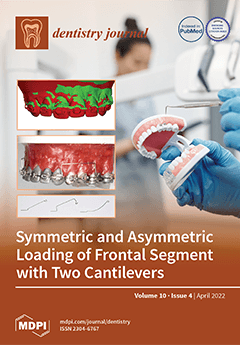Open AccessEditor’s ChoiceArticle
Early Preventive Dental Visits: Do They Reduce Future Operative Treatments?
by
Man Hung, Frank W. Licari, Martin S. Lipsky, Ryan Moffat, Val Joseph Cheever, Amir Mohajeri, Michael Stewart, Dean Orton and David Stewart
Cited by 3 | Viewed by 2826
Abstract
This study assessed the longitudinal impact of early preventive dental visits on the number of dental operative procedures in a prevention-oriented pediatric dental practice. Inclusion criteria consisted of patients zero to four years of age with at least two years of preventive services
[...] Read more.
This study assessed the longitudinal impact of early preventive dental visits on the number of dental operative procedures in a prevention-oriented pediatric dental practice. Inclusion criteria consisted of patients zero to four years of age with at least two years of preventive services provided by the practice. Early preventive visits were the intervention and dental operative procedures were the assessed outcome. The goal was to determine if preventive visits at an early age decreased the number of operative procedures needed by the patient. The patients were divided into two groups: those with older siblings in the practice and those without older siblings in the practice. A secondary outcome was to compare these two patient groups to determine if a child who had older siblings previously treated in this preventive practice had better outcomes than those without siblings in the practice. ANCOVA tests were used to compare the average number of operative procedures in two age groups (<2 years and ≥2 years), and for those with and without dental insurance, in addition to children being younger sibling versus children without sibling, adjusting for the effect of covariates. The study sample consisted of 363 pediatric patients. Patients’ age at first visit ranged from 0 to 4 years old (mean = 2.13; SD = 1.15). The average number of operative procedures per year increased as the age at first visit increased (
p < 0.05). The average number of operative procedures in two age groups (<2 years and ≥2 years) differed (
p < 0.05) with those whose age at first visit ≥2 years experiencing more dental operative procedures than the younger group. The average number of operative procedures was similar between younger siblings (mean = 1.91; SD = 7.44) and children without siblings (mean = 1.54; SD = 2.1) (
p > 0.05). The difference in the average number of operative procedures in children with insurance (mean = 1.59; SD = 5.25) and children without insurance (mean = 1.58; SD = 2.38) was non-significant (
p > 0.05). More dental cleaning examinations were associated with fewer dental operative procedures (
p < 0.05). These findings demonstrate that dental examinations before two years of age and more dental cleaning examinations lead to a decrease in the number of dental operative procedures needed by children.
Full article






